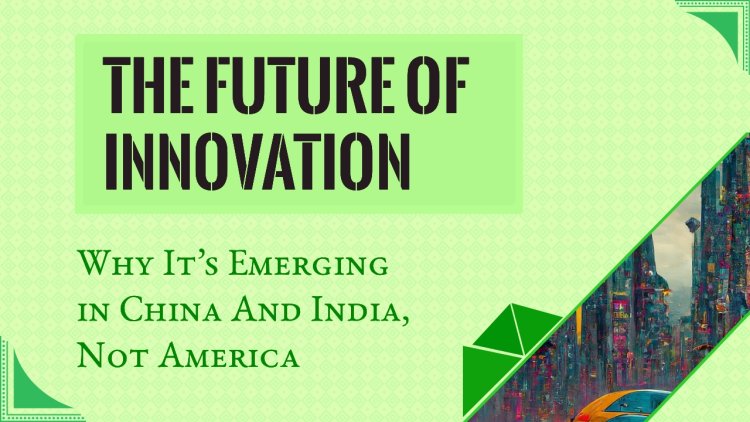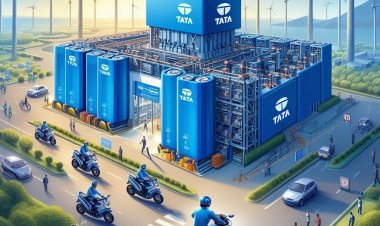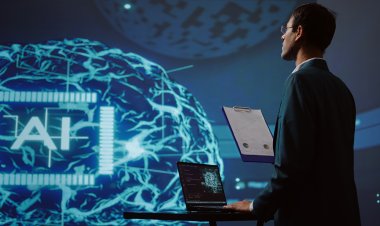The Future of Innovation: Why It’s Emerging in China And India, Not America
Discover why the future of innovation is shifting to China and India, not America. Explore how embargoes, sanctions, and China’s digitized advantage are reshaping global tech dominance. Is the US losing the innovation race?

Recently, I faced a choice in Shanghai: visit the American-themed Tomorrowland at Shanghai Disneyland or explore the genuine Tomorrowland — Huawei’s sprawling new research campus, covering an area equivalent to 225 football fields. I chose Huawei’s.— a vast and ambitious research campus created by the Chinese tech giant Huawei. Naturally, I chose the latter.
What I saw was awe-inspiring — and deeply unsettling:
The Huawei campus is astonishing. Completed in just over three years, it features 104 uniquely designed buildings, manicured lawns, a Disney-style monorail, and facilities for up to 35,000 scientists and engineers. It includes 100 cafes and fitness centers, all crafted to attract top talent from China and abroad.It’s China’s powerful answer to America’s 2019 tech sanctions, meant to cripple Huawei by cutting off access to U.S. semiconductors and software. Rather than crumpling, Huawei innovated — fast.
This campus symbolizes Huawei’s response to U.S. efforts since 2019 to restrict its access to American technology, especially semiconductors, citing national security. Despite these sanctions, Huawei innovated aggressively. It launched the Mate 60 smartphone series with advanced semiconductors, developed the world’s first triple-folding smartphone, and created its own mobile operating system, Hongmeng (Harmony), competing with Apple and Google. Huawei is also pioneering AI technologies for electric vehicles, autonomous mining equipment, and more. In 2024 alone, it installed 100,000 fast chargers for electric vehicles across China, vastly outpacing U.S. infrastructure efforts.
Watching this unfold is unsettling. While U.S. political focus drifts to cultural issues and tariff battles, China is transforming its manufacturing with AI to surpass American factories. The U.S. strategy under President Trump, centered on tariffs and cutting scientific funding, contrasts sharply with China’s commitment to expanding research and AI innovation.
It introduced the Mate 60 smartphone with advanced chips made in-house, launched the world’s first triple-fold phone, and developed its own operating system to compete with iOS and Android. In 2024 alone, the company deployed 100,000 electric vehicle fast chargers across China. For context, after allocating $7.5 billion in 2021 for similar infrastructure, the U.S. had only installed 214 EV chargers by late 2024.
While China supercharges its factories with AI, America is stuck in partisan battles about culture wars and tariffs. President Trump’s approach — clinging to tariffs and neglecting investment in innovation — contrasts sharply with China’s full-steam-ahead strategy to dominate emerging tech.
A recent comment from a seasoned American businessman in China stuck with me: “There was a time when people came to America to see the future. Now they come here.”

Huawei’s Comeback:
Huawei’s financial comeback is remarkable, with net profits doubling in 2024 thanks to homegrown chips. Some U.S. politicians underestimate China’s innovation capacity, but the reality is starkly different.
China’s success stems from a robust “fitness club” model: a massive emphasis on STEM education producing 3.5 million graduates annually, vocational schools supplying skilled tradespeople, and a highly connected infrastructure enabling rapid manufacturing and delivery. This ecosystem is infused with AI at every level, enhancing design, testing, and production.
China’s tech ecosystem is advancing rapidly, as seen in the development of DeepSeek, an open-source AI engine, and widespread AI adoption in manufacturing. The government actively supports large-scale AI applications, fostering a culture where even simple production lines are AI-driven.
Despite these strengths, China does not desire a trade war. Economic challenges, including a housing bubble and slowing growth, make stable trade relations with the U.S. vital. However, unpredictable U.S. policies under Trump complicate negotiations, risking both countries’ economic futures.
Despite American efforts to cripple it, Huawei bounced back. In 2024, its profits more than doubled, thanks to hardware powered by its own chips. The U.S. mindset that China can only innovate by copying is dangerously outdated.
Meanwhile, in Washington, the political consensus too often consists of bashing China, waving flags, and assuming that democracies automatically out-innovate autocracies. But the facts on the ground — and in the lab — say otherwise.
If patriotism means anything, it’s about confronting hard truths. America’s strategy must change — not through magical thinking that tariffs alone will rebuild industry, but through a grounded strategy: “Made in America, by American workers, in partnership with Chinese capital and technology.”
A sustainable path forward is a partnership model: “Made in America, by American workers, in collaboration with Chinese technology and capital.” This reverses the 1990s strategy of “Made in China” with foreign technology and investment. Joint ventures could allow Chinese firms to enter the U.S. market, increasing local sourcing and fostering innovation.
This approach requires rebuilding trust, currently scarce in U.S.-China relations. Without it, protectionist measures risk inflation and stagnation rather than prosperity. Banning Chinese investment or ownership, as some U.S. states propose, would be counterproductive, excluding valuable expertise and capital.
Global interdependence is inevitable. The choice is whether to build healthy partnerships and rise together or maintain adversarial stances and fall together. The future of innovation and economic strength depends on recognizing this reality and adapting accordingly.
The Myth of Instant Industrial Revival
Trump’s belief that walls and China tariffs will instantly revive American manufacturing is fantasy. Complex products like iPhones or EVs are built by intricate global supply chains. Even Tesla imports parts.
Yes, China’s rise included unfair practices — tech transfers, IP theft — but that’s not the full story. Today, it’s about speed, scale, and smarts. China produces 3.5 million STEM graduates per year. It has the workforce, infrastructure, and supply chains to iterate and scale faster than almost anyone.
Want a factory? It gets built in weeks. Need a hyper-specific component? Delivered by tomorrow. Want it optimized with AI? Already done.

China’s Digitized Advantage
This isn’t just about hardware. It’s about a fully digitized ecosystem — from facial recognition hotel check-ins to tech-savvy beggars with QR codes. And now, AI is being infused into every layer of this system, supercharging the entire manufacturing process.
China’s DeepSeek, an open-source AI engine built with fewer U.S. chips, is just one example. The country isn’t waiting. As one engineer told me, “You are preparing to use AI even if you don’t know how — because your boss told you to.”
Meanwhile, in the U.S.
In stark contrast, American lawmakers avoid traveling to China out of fear of political backlash. That blindness is dangerous. “China is defining the tech standards of the future without U.S. input,” warns Han Shen Lin, China director for the Asia Group.
The U.S. isn’t just losing a race — it’s refusing to show up for the start.
China’s Vulnerabilities — and Its Need for Trade
Despite its strengths, China faces major economic pressure. A collapsed real estate market has left middle-class investors shaken. Many are now hoarding cash due to minimal public safety nets. The government needs export growth, and thus, needs a trade deal with the U.S.
But Trump’s erratic negotiating style makes Beijing wary. Michele Gelfand, a Stanford expert on negotiations, noted, “Great negotiators know that trust, not chaos, is what gets lasting results.”
Toward a New Model: Co-opetition
Here’s a vision worth pursuing: Made in America, by American workers, in collaboration with Chinese technology and capital. It mirrors China’s own strategy from the 1990s, when it partnered with Western firms to accelerate growth.
Let Chinese companies partner with U.S. firms under strict conditions — like increasing local sourcing over time. That requires rebuilding trust and shifting from paranoia to pragmatism.
Some lawmakers, though, still act out of fear. In Texas, for instance, legislation was introduced to ban property ownership by Chinese nationals. That’s short-sighted. Instead of pushing away global talent and capital, we should be offering structured partnerships.
The Bigger Picture: Interdependence Is Inevitable:
In conclusion, the future is unfolding in China, driven by massive investment in research, AI, and manufacturing innovation. America must confront this reality honestly and seek collaborative strategies that leverage the strengths of both nations to secure shared prosperity in the coming AI era.
Like it or not, we’re all in this together. Technology, trade, and climate have made global interdependence our reality — not a choice. As Dov Seidman puts it, “Our only choice is whether we forge healthy interdependencies and rise together — or maintain unhealthy ones and fall together.”
Let’s hope our leaders remember that — before there’s nothing left to lead.
Additional Notes:
Huawei is setting some benchmarks on how R&D is done.
- It has launched open the world’s biggest R&D-only facility, which will house 30k people
- Probably, all of India’s Top 10 companies combined would have fewer people working on R&D
This is a massive $1.4bn compound in Shanghai. The focus is singular: research and development around cloud computing, semiconductors, IoT, wireless technologies, and AI/ML. That’s it.
..
Quite an amazing ride, which Huawei has been through in such a short while.
From being a global pariah to being a global heavyweight challenger, looking the Western biggies eye to eye in every field it gets into.
It’s building smartphones which have shaken Apple’s perceived indomitable hold on Chinese consumers.
It’s building chips in-house, just like Apple also does. Simply amazing.
..
And for those who don’t know:
Huawei for the last decade has been China’s No.3 filer of patents.
In these 10 years, it has filed 50k+ patents, mostly around the technologies its new R&D centre will also focus on.
Thus, it’s amply clear that the dominant force has emerged due to over a decade of R&D efforts.
And that’s something I guess, no Indian company is seen to be doing.

 Editor
Editor 































